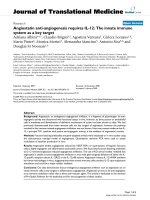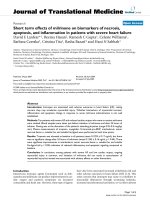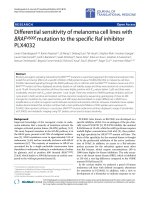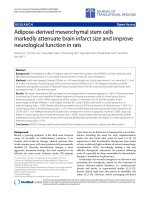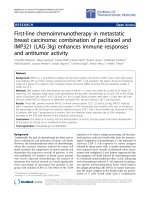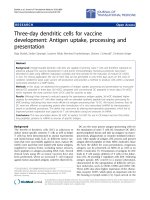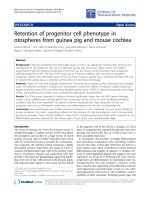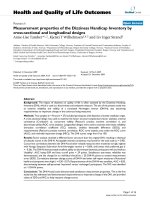báo cáo hóa học:" Recombinant HPV16 E7 assembled into particles induces an immune response and specific tumour protection administered without adjuvant in an animal model" doc
Bạn đang xem bản rút gọn của tài liệu. Xem và tải ngay bản đầy đủ của tài liệu tại đây (1.2 MB, 9 trang )
RESEARC H Open Access
Recombinant HPV16 E7 assembled into particles
induces an immune response and specific
tumour protection administered without adjuvant
in an animal model
Linda Petrone
1
, Maria G Ammendolia
2
, Armando Cesolini
1
, Stefano Caimi
3
, Fabiana Superti
2
, Colomba Giorgi
1
and
Paola Di Bonito
1*
Abstract
Background: The HPV16 E7 protein is both a tumour-specific and a tumour-rejection antigen, the ideal target for
developing therapeutic vaccines for the treatment of HPV16-associated cancer and its precursor lesions. E7, which
plays a key role in virus-associated carcinogenesis, contains 98 amino acids and has two finger-type structures
which bind a Zn
++
ion. The ability of an Escherichia coli-produced E7-preparation, assembled into particles, to
induce protective immunity against a HPV16-related tumour in the TC-1-C57BL/6 mouse tumour model, was
evaluated.
Methods: E7 was expressed in E. coli, purified via a one-ste p denaturing protocol and prepared as a soluble
suspension state after dialysis in native buffer. The presence in the E7 preparation of particulate forms was analysed
by non-reducing SDS-PAGE and negative staining electron microscopy (EM). The Zn
++
ion content was analysed by
mass-spectrometry. Ten μg of protein per mouse was administered to groups of animals, once, twice or three
times without adjuvant. The E7-specific humoral response was monitored in mice sera using an E7-based ELISA
while the cell-mediated immune response was analysed in mice splenocytes with lymphoproliferation and IFN-g
ELISPOT assays. The E7 immunized mice were challenged with TC-1 tumour cells and the tumour growth
monitored for two months.
Results: In western blot analysis E7 appears in multimers and high molecular mass oligomers. The EM micrographs
show the protein dispersed as aggregates of different shape and size. Th e protein appears clustered in micro-,
nano-aggregates, and structured particles. Mice immunised with this protein preparation show a significant E7-
specific humoral and cell-mediated immune response of mixed Th1/Th2 type. The mice are fully protected from
the tumour growth after vaccination with three E7-doses of 10 μg without any added adjuvant.
Conclusions: This report shows that a particulate form of HPV16 E7 is able to induce, without adjuvant, an E7-
specific tumour protection in C57BL/6 mice . The protective immunity is sustained by both humoral and cell-
mediated immune responses. The E. coli-derived HPV16 E7 assembled in vitro into micro- and nanoparticles
represents not only a good substrate for antigen-presenting cell uptake and processing, but also a cost-effective
means for the production of a new gene ration of HPV subunit vaccines.
* Correspondence:
1
Department of Infectious Parasitic and Immune-mediated Diseases, Istituto
Superiore di Sanità, Viale Regina Elena 299, 00161 Rome, Italy
Full list of author information is available at the end of the article
Petrone et al. Journal of Translational Medicine 2011, 9:69
/>© 2011 Petrone et a l; licensee BioMed Central Ltd. This is an Open Access article distributed under the terms of the Cr eative Commons
Attribution License ( which permits unrestricted use, distribution, and reproduction in
any medium, provided the original work is properly cited .
Background
Human Papillomavirus type 16 (HPV16) is associated
with the development of benign and malignant lesions
of the oral and genital tract [1]. The oncogenic potential
of HPV16 is mainly ascribed to the viral oncoprotein
E7, which has been shown to interact with a variety of
cellular proteins. HPV16 E7 is a 98-amino-acid phos-
phoprotein (11 kDa) that binds the Zn
++
ion through
two Cys-X-X-Cys motifs proposed to be involved in
protein oligomerization [2-4]. An ATP-independent cha-
perone holdase activity was recently detected as the first
biochemical activity of HPV16 E7 [5] . E7 is a tumour
specific antigen (TSA), the mediator of tumour recogni-
tion by t he host immune respo nse [6], hence an ideal
target for the development of therapeutic vaccines for
treating HPV16-associated cancer and its precursor
lesions [7-9].
HPV16 E7 has been expressed in various eukaryotic
and prokaryotic systems [10-26] since the end o f the
80s. The main objective was to produce and purify E7
in the native form to study both, its molecular structure
and its cell transformation activity in vitro.Someof
these studies have also shown the ability of E7 to form
aggregates when present in high quantities. Electron
microscopy micrographs of bacterial-derived E7 aggre-
gates in particles have been shown only by Chinami et
al. [20] and Alonso et al.[27].Bacteria-derivedE7
maintains the antigenic properties of the native protein,
being recognised by sera from HPV infected subjects
and has therefore been used in HPV serology [28-31].
The E7 protein was extensively used in vaccine devel-
opment. It is a small protein poorly immunogenic ( 11
kDa) hence it was used with immunological adjuvants,
protein a nd gene ca rriers. Various forms of therapeutic
vaccines based on E7 have b een developed and te sted in
animal models. Most of the vaccines induced E7-specific
CTLs and were effective in HPV16-related tumour
regression in animal models. Never theless, only few
have reached the clinical trial phase [7-9]. As the
HPV16 mouse tumour model [32] had b een made avail-
able to the research community and was easy to set up,
considerable work was done using E7 as antigen to
demon strate the efficacy of various adjuvants, molecular
carriers and genetic vectors as inductors or enhancers of
T cell response [9]. E7 has also been, fused to a number
of peptides and proteins, even those of HPV16 such as
L1, L2 and E6 with the aim to combine HPV prophylac-
tic and therapeutic vaccines [6-9].
Recent progress in elucidating the cross-presentation
mechanism and the role of particulate antigens in CTL
immunity [33] encour aged us to use the immunogeni-
city of a bacterial-derived HPV16 E7, in particle form,
to explore the possible development of a therapeutic
vaccine against HPV16 related tumours.
This paper shows that a bacterial-derived HPV16 E7
assembles in micro- and nanoparticles on dialysis i n
buffer containing DTT and induces protective immunity
against a tumour cell challenge in an HPV16 mouse
tumour model. Interestingly, the E7 particles was admi-
nistered without adjuvant. The protection of mice from
tumour growth induced by the E7 particles is mediated
by a strong E7-specific humoral and cell mediated
immune response.
Methods
Protein expression and purification
Freshly streaked bacterial colonies, containing the E7 plas-
mid [30], were inoculated in 25 ml LB medium (DIFCO)
and grown to saturation overnight (O/N) at 37°C. The cul-
ture was then inoculated in 500 ml LB, and grown until
the culture density reached OD
600
= 0.6. The His-E7 pro-
tein was induced by the addition of 1 mM IPTG (A.G.
Scientific, Inc) for 3 h. The culture was harvested and cen-
trifuged for 30 min in a Sorval centrifuge at 6000 rpm in
GSA rotor. The bacterial pellet was lysed for 30 min in a
rotator at room temperature (R/T) in a denaturing buffer
(40 ml) containing 8 M urea (MP Biomedicals, Inc), 10
mM NaH
2
PO
4
,10mMTris-HClpH8,300mMNaCl,1
mM DTT, (Sigma-Aldrich), 1% Triton-X 114 (Sigma-
Aldrich) and 1% Triton X-100 (Buffer B mod). To break
the DNA, the lysate was s onicated for 60 min in the
pulsed mode (50% on/off pulse; effective sonication time,
30 min) using an ultrasonic processor (Vibra-Cell 400,
Sonics). The lysate was clarified in a Sorval centrifuge for
20 min at 10.000 rpm in a SS34 rotor. The supernatant
was incubated for 30 min with 4 ml of 50% slurry NiNTA
resin (QIAGEN) at RT. To reduce the endotoxin content,
the E7-NiNTA agarose suspension was collected in a 50
ml tube, extensively washed in batch and spun down in a
centrifuge at 500 × g. The E7-NiNTA was sequentially
washed in Buffer B (pH 8, without detergents) containing
10% glycerol (100 ml), 20% ethanol (100 ml) and 60% iso-
propanol (200 ml). The isopropanol washes were alter-
nated with cold 10 mM Tris-HCl washes (200 ml) [34].
The last sequential washes were performed using 500 ml
Buffer C (8 M urea, 10 mM NaH
2
PO
4
,10mMTris-HCl
pH 6.3). The protein was eluted by gravity-flow in several
2 ml fractions from packed E7-Ni-NTA using 1 M Imida-
zole (Sigma-Aldrich) in Buffer B. After an analytical Coo-
massie stained SDS-PAGE, the fractions containing E7
were collected and the protein was subjected to 2 step-dia-
lysis at 4°C in native buffers. The first step was performed
in 2 L of buffer containing 25 mM Tris, 50 mM NaCl pH
7.5 (TN) in presence of 1 mM DTT and the second step
was performed in 2 L of TN buffer only. E7 was conce n-
trated in a centrifugal filter device up to a final concentra-
tion of 2 mg/ml. All the reagents were ultrapure grade.
The E7 protein yield was 20 mg/l of medium culture. The
Petrone et al. Journal of Translational Medicine 2011, 9:69
/>Page 2 of 9
protein was quantified by standard methods (Protein BC
assay, BIORAD); its purity and identity were monitored by
SDS-PAGE followed by Coomassie brilliant blue staining
and western blotting (30). The endotoxin contamination
was as low as 0.5 EU/mg protein as monitored by LAL
assay (QCL-1000, Lonza). The presence of E7 particles
was monitored by negative stain EM.
SDS-PAGE and Western Blot analysis
Protein sa mples were separated in 12.5% polyacrylamide
gels in Leammli Tris-Glycine buffer and blotted into an
Immobilon-P membrane. In a non-reducing gel, the
protein samples were denatured in SDS-loading buffer
[30] without b-mercapto- ethanol. The protein was iden-
tified by Western blot using both commercial monoclo-
nal and in-ho use prepared polyclona l anti-E7 antibodies
[30]. A peroxidase-conjugate rabbit anti-mouse IgG (H
+L) (Sigma-Aldrich) was used as secondary antibody.
The immune complexes were revealed with a chemilu-
minescence substrate (PIERCE).
Electron Microscopy Analysis
10 μl samples of the E7 preparation (2 mg/ml) were
adsorbed for 1 min onto Formvar-coated c opper grids,
then rinsed briefly with water and negatively stained
with 2% filtered aqueous sodium phosphotungstate
adjusted to pH 7.0. Negatively stained preparations were
observed wit h a Philips 208S transmission electron
microscope at 80 kV.
Zn analysis
Three samples of different E7 preparations and, as a
control, thre e samples of Glutathion e-S-transferase
(GST) were analysed for their content of
66
Zn and
68
Zn
analytical masses. The GST protein was produced in
pGEX-2T transformed E. coli and purified by glu-
tathione affinity chromatography ( PIERCE). Measure-
ments were performed by means of High Resolution
Inductively Coupled Plasma -Mass Spectrometry (HR-
ICP-MS), using an Element2 apparatus (Thermo-Finni-
gan, Bremen, Germany). HR-ICP-MS is a well estab-
lished and powerful analytica l technique for the
determination of trace and ultra-trace elements in biolo-
gical samples. The calibration of the method was per-
formed by the adoption of the standard addition mode:
diluted single-element standards were added to the ana-
lytical solutions. To compensate for instrumental drifts
and matrix effects, indium was added to ea ch sample as
an internal standard.
Mice immunization and tumour protection assay
6-8 week-old female C57BL/6 mice were purchased
from Charles River Laboratories and maintained under
pathogen-free conditions for one week before the
experiment. The animal care and the experiments fol-
lowed the European Directive 86/609 EEC. The protocol
of animal use was evaluated by the Service for Biotech-
nology Animal Welfare of the Istituto Superiore di
Sanità, and approved by the Italian Ministry of Health.
Three groups of mice (14 per group) were inoculated
subcutaneously with 1, 2 or 3 doses of 10 μg E7 respec-
tively, at 1 week intervals. A fourth mouse group was
inoculated with a saline solution and used as a control
(naïve). Two weeks after the last immunization, 4 mice
of each group were sacrificed to analyse the immune
response and 10 mice were inoculated subcutaneously
with 1 × 10
5
TC-1 cells/mouse, as described [35]. The
TC-1 cells were grown in complete medium with 0. 4
mg/ml G418. C ells at 50% confluence were harvested,
counted and rinsed in Hank’smediumat1×10
6
cells/
ml for the inje ction in mice . Tumour growth was moni-
tored by visual inspection and palpation once a week for
2 months. The experiment was performed twice.
Lymphoproliferation and IFNg-ELISPOT assays
Splenocytes from mice of the same immu nization group
were pooled and enriched in CD4
+
and CD8
+
cells
using the Dynal Mouse T cell Negative isolation kit
(Invitrogen). Cells were cultured in RPMI 1640 (Lonza)
supplemented with 10% FCS, 1% penicillin/streptomy-
cin, 2 mM glutamine, 1 mM pyruvate and 1% non-
essential amino acids (Lonza) (complete RPMI). To
assess cell proliferation, the splenocyte pools (2 × 10
5
cells/well, in triplicate) were stimulated for five days in
thepresenceof5μg/ml of two 8- and 9-mer E7 pep-
tides, DLYCYEQL (aa 21-28) and RAHYNIVTF (aa 49-
57), already known to efficiently bind the H-2 K
b
com-
plex of C57 Black/6 mice [36]. On day 6, the cells were
pulsed with 0.5 μCi [
3
H] thymidine per well and incu-
bated for 18 h. The cells were then harvested onto fil-
ters using an automatic harvester and counte d in a Beta
Counter ( Wallac). The results were expressed in stimu-
lation index (SI), calculated by dividing the mean counts
per minute (cpm) of cells exposed to the E7 pepti des by
the mean cpm of cells incubated only with medium.
The IFN-g ELISPOT assay was performed using com-
mercially available reagents (Mabtech AB). T-cell
enriched splenocytes were seeded in triplicate (5 × 10
5
cells per well) in 200 μl complete medium with the E7
stimulator peptides. After 18 h at 37°C in a humidified
5% CO
2
incubator, the plates were analysed for the pre-
sence of IFN-g as described in [35].
Antibody assay
The sera from each group o f immunized mice were
pooled and analysed. To determine the anti-E7 specific
IgG titre the sera pools were serially diluted (two-fold)
and assayed by ELISA [30]. The end-point dilution
Petrone et al. Journal of Translational Medicine 2011, 9:69
/>Page 3 of 9
corresponded to an OD absorbance < 0.1 at 450 nm. Sera
pools diluted 1:100 were used to analyse the anti-E7 IgM,
IgA and the IgG isotypes (IgG1, Ig G2b, IgG2c and IgG3).
Antigen-antibody complexes were detected using the fol-
lowing HRP-secondary antibodies (Sigma-Aldrich): rabbit
anti-mouse IgG (H+L), goat anti-mouse IgM (μ-chain),
goat anti-mouse IgA (a-specific), goat anti-mouse IgG1,
IgG2b, IgG3, IgG2c. HRP activity was revealed using tet-
ramethyl benzidine substrate (TMB) in the presence of
H
2
O
2
. After 30 min at RT, the enzymatic reaction was
stopped by adding 50 μl of 1 M sulphuric acid/well.
Washing steps were done with 400 μl/well of PBS con-
taining 0.05% Tween-20 in an automatic washer.
Statistical analysis
Significance analysis was performed using the Student t
test for unpaired data . Differences were considered sig-
nificant if P < 0.05.
Results
Analysis of the E7 preparation
The E7 protein was expressed in E. coli with a [His]
6
tag
and purified via a one-step denaturing protocol until a
high level o f homogeneity and low endotoxin content
were achieved [30,34]. The p rotein was prepared in a
soluble suspension state by dialysis in Tris buffer and
then analy sed by western blotting in reducing and non-
reducing SDS-PAGE. In the reducing gel, the E7 protein
appears in monomeric form (Figure 1, lane 1). In non-
reducing gels, based on the analysis of the molecular
mass marker, E7 appears in forms consistent with the
mass of monomer, dimer, trimer, tetramer, octamer and
higher oligomers, suggesting that, in these conditions,
the E7 monomer is the oligomerization unit (lane 2).
Preparations of purified E7 were analysed by negative
staining EM. Figure 2 shows representative EM micro-
graphs of the E7 preparation samples. The protein
appears dispe rsed on the grid as aggregates of different
shape and size (panel A). T he protein appears clustered
in compact-looking spheroidal microaggregates, the
majority ranging between 100 and 200 nm in size (panel
B). In these same samples, E7 also appears assembled in
structured particles that seem to derive from the aggre -
gation of smaller particles (panel C). These particles
resemble the previously described E7 oligomers [27]. A
semi-quantitative analysis by EM counts of micro and
nano-sized particles, ranging b etween 45-200 nm, indi-
cates that E7-aggregates are in the order of 10
5
parti-
cles/ml (not shown). The E7 preparations were also
subjected to EM immunolabelling but neither com mer-
cial anti-E7 monoclonal nor in-house prepared polyclo-
nal antibodies [30] revealed any significant reaction,
suggesting that these antibodies were unsuitable for the
EM observation of E7-particles (data not shown).
HPV16 E7 contains a Zinc finger-like domain that
binds the metal even when the protein is expressed in
E. coli [10, 11]. Since t he E7 purificatio n protocol used
does not employ either chelating agents or Zinc salts,
several E7 samples were analysed for Zn
++
content by
high resolution mass spectrometry (HR-ICP-MS). The
recombinant GST protein was used as a control. The
Zn
++
ion concentration in the E 7 preparations was 1.13
μg/g ± 0.10 while GST showed only trace level of Zn
++
(0.19 μg/g ± 0. 02). The metal/protein ratio was
Figure 1 Western blo t analysis. Western blot analysis of the
HPV16 E7 produced in E. coli in reducing (lane 1) and non-reducing
conditions (lane 2). Molecular mass markers are indicated on the left
and the E7 isoforms are indicated on the right.
Petrone et al. Journal of Translational Medicine 2011, 9:69
/>Page 4 of 9
calculated to be 0.19, therefore only about 19% of the E7
molecules were bound to Zn
++
.
Induction of tumour-protective immunity
To investigate if this E. coli-derived HPV16-E7 prepara-
tion, administrated without adjuvant, was able to induce
a tumour-protective immunity, groups of mice were
inoculated with 10 μg of protein per mouse, 1, 2 or 3
times, at one week intervals. As a control group, mice
were inoculated with a saline solution (naïve group).
Two weeks after the last immunization, some of the ani-
mals were bled and killed to analyse the immune
response, in vitro. The remaining animals were chal-
lenged with the TC-1 tumour cells and the inhibition o f
tumour growth in these mice was monitored for 2
months.
To quantify the humoral immune response and to
compare the results obtained from several animal
groups, the sera from the animals of each group were
pooled, t hen sequentially diluted to determine the anti-
body titres by end-point dilution in an E7-based ELISA
[30]. The anti-E7 IgG titre was 1:200 after a single
immunization and progressively increased in mice
immunized 2 and 3 times, reaching 1:8000 and 1:16000
respectively. The presence of IgM and IgA was analysed
in comparison with the IgG and the results are shown
in Figure 3. In panel A, the anti-E7 specific antibodies
of mice immunised 1, 2 or 3 times either with E7 or a
saline solution are shown. The sera show an increase of
anti-E7 specific IgG already after the second protein
dose; IgMs were detected only after the third E7-dose,
while IgAs were never detectable. Animals inoculated
with 3 doses of saline solution did not show any E7 spe-
cific antibody response (naïve, panel A).
The therapeutic effector functions of antibodies
depend on their class and subclasses [37]. In order to
better evaluate the E7-specific humoral immune
response, the anti-E7 specific IgG1, IgG2b, IgG2c
(IgG2a) and IgG3 antibody subclasses were also deter-
mined. The results, shown in Figure 3, panel B, show
that the IgG2b level was significant after the second
immunization while the level of IgG2c was significant
only after the third immunization. The level of IgG1
was not significant and IgG3s were undetectable. This
anti-E7 IgG isotype profile indicates that the immune
response induced in vaccinated mice is a mixed Th1/
Th2 type.
To analyse the induction of the cell-mediated immune
response in mice after 1, 2 or 3 doses of the E7 prepara-
tion, T-enriched splenocytes from mice of the same
immunization group were stimulated in vit ro,withthe
E7-specific CTL peptides and processed for T cell prolif-
eration and g-IFN ELISPOT assays. Splenocytes from
Figure 2 Electron micrographs. Electron micrographs of the
negatively stained E7 preparation samples. Panel A. E7 particles of
different shape and size. Panel B. Spheroidal microaggregates of
compact aspect. Panel C. Highly structured E7-particles of different
size are indicated by arrows. The magnitude scale bars are
indicated.
Figure 3 Analysis of the antibody response.PanelA.ELISA
results showing the anti-E7 IgG (black bars), IgM (white bars) and
IgA (grey bars) reactivity of the pooled mice sera samples either
naïve or immunised with 1, 2 or 3 E7 doses. Panel B. ELISA results
showing the anti-E7 IgG1, 2b, 2c and 3 isotype reactivity of the
pooled mice sera samples.
Petrone et al. Journal of Translational Medicine 2011, 9:69
/>Page 5 of 9
naïve mice were pulsed with an unrelated mixture of
peptides used as control. The results are shown in Fig-
ure 4. Splenocyte s from mice immunised with 2 and 3
doses of E7 showed a high Stimulation Index (SI) sug-
gesting that spe cific T clone selection occurred af ter E7
peptide stimulation. Splenocytes from naïve mice and
from mice immunised once showed non-significant SI.
Conversely, in the g -IFN ELISPOT assay (panel B) only
the splenocytes of mice that received 3 E7 doses, stimu-
lated with the E7-specific CTL peptides, showed a sig-
nificant level of E7-specific g-IFN produci ng cells (panel
B, 3).
To evaluate the efficacy of the E7 preparation as
inductor of anti-tumour immunity, the mice immunised
with 1, 2 or 3 doses of E7 were challenged wit h the TC-
1 tumour cells, and the tumour growth was monitored
for two months after the challenge. The results a re
shown i n Figure 5. Mice vaccinated with three doses of
E7 particles were fully protected from tumour growth.
Only 40% of the mice immunised with 2 doses of E7
were tumour free, whereas the mice immunised with 1
dose and the naïve mice d eveloped a palpable tumour
within 4 weeks of tumour-monitoring, after the chal-
lenge with TC-1 cells.
Discussion
This study reports the induction in mice of a tumour-
protective immunity using an E. coli-derived HPV-E7
preparation containing particles. E7 has been intensively
studied for many years. However, this is t he first time,
to our knowledge, that a particulate form of E7 has
been used as an immunogen and proposed as a non-
adjuvated vaccine. Our results show that, the tumour-
protective immunity in the mouse TC1/C57BL/6
tumour model correlates to the elicited E7-specific T
cell response, and to the IgG isotype switching (IgG2b
and IgG2c).
Previous studies on bacterial-derived E7 showed that
Zinc has a role in E7 particle formation. Chinami et al.
[20] obtained E7 nanoparticles using Zinc acetate both in
culture medium and purification buffers. On the contrary,
Alonso et al. [27] obtained well defined-E7 oligomers after
EDTA chelation of Zinc. For our E7 preparations, neither
the culture medium nor the purification buffers contained
Zinc salts. The analysis of the Zinc content in our protein
preparation indicates that only 19% of E7 binds the metal,
suggesting that several forms of particles could be gener-
ated from the bacterial-derived E7. The metal does not
seem important for the formation of our E7 micro- and
nanoparticles, at least not in the experimental conditions
used here. We did not increase the Zn
++
content in the E7
preparation used as immunogen in mice, considering that
while Zn
++
is an essential mineral in eukaryotic systems, a
high quantity of the metal is also toxic [38]. When Zinc
was removed from the E7 preparation by dialysis in the
presence of 1 mM EDTA, the protein’ ssolubility
decreased resulting in salting out of E7 as large aggregates
without forming micro- and nanoparticles, as observed by
EM (data not shown).
As the aim was to obtain a highly immunogenic E7
preparati on, we did not focus on obtaining identical
Figure 4 Analysis of the cell-mediated immune response. Panel
A. T cell proliferative response of C57BL/6 naïve and mice
immunised with 1, 2 o 3 E7 doses. Panel B. IFN g- secreting cells
from naïve mice and mice immunised with 1, 2 o 3 E7 doses. Cells
were stimulated with two CTL E7 peptides (black bars) or with an
unrelated peptide (grey bars).
Figure 5 Tumour protection experiment. Mice either naïve or
vaccinated with 1, 2 and 3 doses of E7 were challenged with 1 ×
10
5
TC-1 tumour cells and the tumour growth was monitored
weekly. The percentages of mice without tumour are indicated.
Petrone et al. Journal of Translational Medicine 2011, 9:69
/>Page 6 of 9
particles, considering that particles of different size can
be taken up by different types of antigen presenting
cells, such as dendritic cells, macrophages and polymor-
phonuclear leukocytes, sustaining a more potent
immune response [39,40]. However, we standardized the
different preparations by semi-quantitative counting of
particles on EM micrographs (not shown).
The immunogenicity of E. coli-derived E7 fused,
through the N-terminus, to either HPV16 E6 or GST,
was also investigated in mice. An antigen-specific
immune response of Th2 polarity was obtained when
the fusion proteins were administered to mice without
adjuvant (data not shown). However, we were unable to
observe the typical micro- and nanoparticles in these
E7-fusion proteins prepared from E. coli (data not
shown).
Recently, the cytosolic accumulation of E7-oligomers
shown in HPV16 cervical cancer cell lines and in clini-
cal samp les b y indirect methods, supports a new
hypothesis regarding the presence of E7 isoforms and
their role in different cell compartments [41-43]. As
keratinocytes display antigen-presenting cell features
[44], the presence of E7 in different aggregation forms
and cell compartments could affect E7 processing and
presentation by MHC I and II molecule s, determini ng
both the strength and quality of the host’ santi-HPV
immunity.
More studies on recombinant E. coli-derived E7,
assembled in different forms, would contribute to
explaining how the different branches of the immune
system in th e HPV16 mous e tumour model are stimu-
lated. Significant differences exist b etween the HPV16
mouse tumour model and human HPV16-dependent
diseases. However, studies on IgG subclasses and their
FcgR recept ors between mous e and human are compar-
able (37). We bel ieve that HPV16 E7 immunogenicity
studies in mouse will provide insights into th e under-
standing of the protective immunity against human
HPV16 infections as well.
ThecommercialpreventiveHPVvaccineshavehigh
production costs w hich has made widespread vaccina-
tion programs still not possible. Recently, new combined
preventive and therapeutic HPV vaccines produ ced in E.
coli have been described [45-47] and the data presented
here suggests a possible use of E. coli-derived E7 in par-
ticle form in subunit vaccines. The E. coli expressed
proteins represent a well-studied and cost-effective
means for the production of vaccines. These methods
require reduced time, costs, labour and can be easily
scaled up in industrial-scale productions. A generation
of new low-cost HPV vaccines could represent the onl y
possibility for women living in developing countries to
gain access to HPV vaccination programs to prevent or
treat pre-cancerous lesions and cancer.
Conclusions
The paper describes, for the first time, the use of recombi-
nant HPV16 E7, assembled in vitro into particulate form,
to induce protective immunity against a HPV16-related
tumour in an HPV16 mouse tumour model. Dat a show
that E7 particles, used without adjuvant, are excellent sti-
mulators of the immune system. In C57BL/6 mice, the E7
preparation induces anti-tumour immunity sustained by
both humoral and cell-mediated immune responses. This
E7 pro tein (derived from Escherichia coli)withoutadjuvant
could represent, along with the recently proposed E. coli-
derived HPV antigens [45-47], a low cost constituent for
the development of a new generation of HPV16 vaccines,
which combine prophylactic and therapeutic activities.
Acknowledgements and Funding
We wish to thank Professor T.C. Wu for kindly providing the TC-1 cell line, Dr
Jill Marturano for reading and discussing this manuscript, Mr Andrea
Giacomelli and Mrs Monica Gabrielli of the MIPI-animal care unit, and Mr
Valter Tranquilli for assistance in computer artwork. The work was supported
by the Project on Oncology (2007-2010) of the Italian Ministry of Health.
Author details
1
Department of Infectious Parasitic and Immune-mediated Diseases, Istituto
Superiore di Sanità, Viale Regina Elena 299, 00161 Rome, Italy.
2
Department
of Technology and Health, Istituto Superiore di Sanità, Viale Regina Elena
299, 00161 Rome, Italy.
3
Environment and Primary Prevention Department,
Istituto Superiore di Sanità, Viale Regina Elena 299, 00161 Rome, Italy.
Authors’ contributions
LP carried out the biochemical and immunological assays, made
contribution to the analysis and interpretation of the data and helped to
draft the manuscript; MGA carried out the EM analysis and made
contribution in data analysis; AC performed the experiments with the
animals. SC carried out the mass spectrometry experiments; FB made
contribution in data analysis; CG made contribution to the analysis and
interpretation of the data, in critical revision of the manuscript and in
acquisition of funding. PDB conceived and designed the study, analysed and
interpreted the data and drafted the manuscript. All authors read and
approved the final manuscript.
Authors’ information
LP’s present address: Istituto Nazionale Malattie Infettive “L. Spallanzani”,
Rome. CG ‘s present e-mail:
Competing interest
The authors declare that they have no competing interests.
Received: 21 December 2010 Accepted: 18 May 2011
Published: 18 May 2011
References
1. Zur Hausen H: Papillomavirus infections: A Major Cause of Human
Cancer. In Infections Causing Human Cancer. Edited by: Harald zur Hausen.
Weinheim: WILEY-VCH Verlag GmbH 2006:145-243.
2. Wise-Draper TM, Wells SI: Papillomavirus E6 and E7 proteins and their
cellular targets. Frontiers in Bioscience 2008, 13:1003-1017.
3. McLaughlin-Drubin ME, Münger K: The human papillomavirus E7
oncoprotein. Virology 2009, 384:335-344.
4. Ghittoni R, Accardi R, Hasan U, Gheit T, Sylla B, Tommasino M: The
biological properties of E6 and E7 oncoproteins from human
papillomaviruses. Virus Genes 2009, 40:1-13.
5. Alonso LG, Smal C, Garcia-Alai MM, Chemes L, Salame M, de Prat-Gay G:
Chaperone holdase activity of human papillomavirus E7 oncoprotein.
Biochemistry 2006, 45:657-667.
Petrone et al. Journal of Translational Medicine 2011, 9:69
/>Page 7 of 9
6. Coulie PG, Weynants P, Lehmann F, Herman J, Brichard V, Wölfel T, Van
Pel A, De Plaen E, Brasseur F, Boon T: Genes coding for tumor antigens
recognized by human cytolytic T lymphocytes. J Immunother Emphasis
Tumor Immunol 1993, 14:104-109.
7. Hellner K, Münger K: Human Papillomaviruses As Therapeutic Targets in
Human Cancer. J Clin Oncol 2011 [ />1785.full?sid=23bbb452-d962-4f56-acaa-4a40c9093c56], Published online
ahead of print on Jan 10 at.
8. Su JH, Wu A, Scotney E, Ma B, Monie A, Hung CF, Wu TC: Immunotherapy
for cervical cancer: Research status and clinical potential. BioDrugs 2010,
24:109-129.
9. van der Burg SH, Melief CJ: Therapeutic vaccination against human
papillomavirus induced malignancies. Curr Opin Immunol 2011, 23:1-6.
10. Barbosa MS, Lowy DR, Schiller JT: Papillomavirus polypeptides E6 and E7
are zinc-binding proteins. J Virol 1989, 63:1404-1407.
11. McIntyre MC, Frattini MG, Grossmon S, Laimons LA: Human papillomavirus
type 18 E7 protein requires intact Cys-X-X-Cys motifs for zinc binding,
dimerization, and transformation but not for Rb binding. J Virol 1993,
67:3142-3150.
12. Pahel G, Aulabaugh A, Short SA, Barnes JA, Painter GR, Ray P, Phelps WC:
Structural and functional characterization of the HPV16 E7 protein
expressed in bacteria. J Biol Chem 1993, 68:26018-26025.
13. Alonso LG, Garcia-Alai MM, Nadra AD, Lapena AN, Almeida FL, Gualfetti P,
de Prat-Gay G: High-risk (HPV16) human papillomavirus E7 oncoprotein
is highly stable and extended, with conformational transitions that
could explain its multiple cellular binding partners. Biochemistry 2002,
41:10510-10518.
14. Patrick DR, Zhang K, Defeo-Jones D, Vuocolo GR, Maigetter RZ, Sardana MK,
Oliff A, Heimbrook DC: Characterization of functional HPV-16 E7 protein
produced in Escherichia coli. J Biol Chem 1992, 267:6910-6915.
15. Sato H, Watanabe S, Furuno A, Yoshiike K: Human papillomavirus type 16
E7 protein expressed in Escherichia coli and monkey COS-1 cells:
immunofluorescence detection of the nuclear E7 protein. Virology 1989,
170:311-315.
16. Tommasino M, Contorni M, Scarlato V, Bugnoli M, Maundrell K, Cavalieri F:
Synthesis, phosphorylation, and nuclear localization of human
papillomavirus E7 protein in Schizosaccharomyces pombe. Gene 1990,
93:265-270.
17. Carter JJ, Yaegashi N, Jenison SA, Galloway DA: Expression of human
papillomavirus proteins in yeast Saccharomyces cerevisiae. Virology 1991,
182:513-521.
18. Patrick DR, Zhang K, Defeo-Jones D, Vuocolo GR, Maigetter RZ, Sardana MK,
Oliff A, Heimbrook DC: Characterization of functional HPV-16 E7 protein
produced in Escherichia coli
. J
Biol Chem 1992, 267:6910-6915.
19. Park DS, Selvey LA, Kelsall SR, Frazer IH: Human papillomavirus type 16 E6,
E7 and L1 and type 18 E7 proteins produced by recombinant
baculoviruses. J Virol Methods 1993, 45:303-318.
20. Chinami M, Sasaki S, Hachiya N, Yuge K, Ohsugi T, Maeda H, Shingu M:
Functional oligomerization of purified human papillomavirus types 16
and 6b E7 proteins expressed in Escherichia coli. J Gen Virol 1994,
75:277-281.
21. Clemens KE, Brent R, Gyuris J, Münger K: Dimerization of the human
papillomavirus E7 oncoprotein in vivo. Virology 1995, 214:289-293.
22. Zwerschke W, Joswig S, Jansen-Dürr P: Identification of domains required
for transcriptional activation and protein dimerization in the human
papillomavirus type-16 E7 protein. Oncogene 1996, 12:213-220.
23. Clements A, Johnston K, Mazzarelli JM, Ricciardi RP, Marmorstein R:
Oligomerization properties of the viral oncoproteins adenovirus E1A and
human papillomavirus E7 and their complexes with the retinoblastoma
protein. Biochemistry 2000, 39:16033-16045.
24. Mirecka EA, Rudolph R, Hey T: Expression and purification of His-tagged
HPV16 E7 protein active in pRb binding. Protein Expr Purif 2006,
48:281-291.
25. Franconi R, Di Bonito P, Dibello F, Accardi L, Muller A, Cirilli A, Simeone P,
Donà G, Venuti A, Giorgi C: Plant-derived human papillomavirus 16 E7
oncoprotein induces immune response and specific tumor protection.
Cancer Research 2002, 62:3654-3658.
26. Massa S, Simeone P, Muller A, Benvenuto E, Venuti A, Franconi R:
Antitumor activity of DNA vaccines based on the human papillomavirus-
16 E7 protein genetically fused to a plant virus coat protein. Hum Gene
Ther 2008, 19:354-364.
27. Alonso LG, García-Alai MM, Smal C, Centeno JM, Iacono R, Castaño E,
Gualfetti P, de Prat-Gay G: The HPV16 E7 viral oncoprotein self-assembles
into defined spherical oligomers. Biochemistry 2004, 43:3310-3317.
28. Di Lonardo A, Marcante ML, Poggiali F, Venuti A: HPV 16 E7 antibody
levels in cervical cancer patients: before and after treatment. J Med Virol
1998, 54:192-195.
29. Waterboer T, Sehr P, Michael KM, Franceschi S, Nieland JD, Joos TO,
Templin MF, Pawlita M: Multiplex human papillomavirus serology based
on in situ-purified glutathione S-transferase fusion proteins. Clin Chem
2005, 51:1845-1853.
30. Di Bonito P, Grasso F, Mochi S, Accardi L, Donà MG, Branca M, Costa S,
Mariani L, Agarossi A, Ciotti M, Syrjänen K, Giorgi C: Serum antibody
response to Human papillomavirus (HPV) infections detected by a novel
ELISA technique based on denatured recombinant HPV16 L1, L2, E4, E6
and E7 proteins. Infect Agent Cancer 2006, 8:1-6.
31. Ferguson M, Heath A, Johnes S, Pagliusi S, Dillner J: Results of the first
WHO international collaborative study on the standardization of the
detection of antibodies to human papillomaviruses. Int J Cancer 2006,
118:1508-1514.
32. Lin KY, Guarnieri FG, Staveley-O
’Carroll
KF, Levitsky HI, August JT,
Pardoll DM, Wu TC: Treatment of established tumors with a novel
vaccine that enhances major histocompatibility class II presentation of
tumor antigen. Cancer Res 1996, 56:21-26.
33. Ramachandra L, Simmons D, Harding CV: MHC molecules and microbial
antigen processing in phagosomes. Curr Opin Immunol 2009, 21:98-104.
34. Di Bonito P, Grasso F, Mangino G, Massa S, Illiano E, Franconi R, Fanales-
Belasio E, Falchi M, Affabris E, Giorgi C: Immunomodulatory activity of a
plant extract containing human papillomavirus 16-E7 protein in human
monocyte-derived dendritic cells. Int J Immunopathol Pharmacol 2009,
22:967-978.
35. Di Bonito P, Grasso F, Mochi S, Petrone L, Fanales-Belasio E, Mei A,
Cesolini A, Laconi G, Conrad H, Bernhard H, Dembek CJ, Cosma A,
Santini SM, Lapenta C, Donati S, Muratori C, Giorgi C, Federico M: Anti-
tumor CD8+ T cell immunity elicited by HIV-1-based virus-like particles
incorporating HPV-16 E7 protein. Virology 2009, 395:45-55.
36. Bauer S, Heeg K, Wagner H, Lipford GB: Identification of H-2Kb binding
and immunogenic peptides from human papilloma virus tumour
antigens E6 and E7. Scand J Immunol 1995, 42:317-323.
37. Nimmerjahn F, Ravetch JV: Fcgamma receptors as regulators of immune
responses. Nat Rev Immunol 2008, 8:34-47.
38. John E, Laskow TC, Buchser WJ, Pitt BR, Basse PH, Butterfield LH, Kalinski P,
Lotze MT: Zinc in innate and adaptive tumor immunity. J Transl Med
2010, 8:118.
39. Nandedkar TD: Nanovaccines: recent developments in vaccination. J
Biosci 2009, 34:995-1003.
40. Oyewumi MO, Kumar A, Cui Z: Nano-microparticles as immune adjuvants:
correlating particle sizes and the resultant immune responses. Expert Rev
Vaccines 2010, 9:1095-1107.
41. Dantur K, Alonso L, Castaño E, Morelli L, Centeno-Crowley JM, Vighi S,
de Prat-Gay G: Cytosolic accumulation of HPV16 E7 oligomers
supports different transformation routes for the prototypic viral
oncoprotein: the amyloid-cancer connection. Int J Cancer 2009,
125:1902-1911.
42. Valdovinos-Torres H, Orozco-Morales M, Pedroza-Saavedra A, Padilla-
Noriega L, Esquivel-Guadarrama F, Gutierrez-Xicotencatl L: Different
Isoforms of HPV-16 E7 Protein are Present in Cytoplasm and Nucleus.
Open Virol J 2008, 2:15-23.
43. Knapp AA, McManus PM, Bockstall K, Moroianu J: Identification of the
nuclear localization and export signals of high risk HPV16 E7
oncoprotein. Virology 2009, 383:60-68.
44. Nestle FO, Di Meglio P, Qin JZ, Nickoloff BJ: Skin immune sentinels in
health and disease. Nat Rev Immunol 2009, 8:679-691.
45. Schädlich L, Senger T, Kirschning CJ, Müller M, Gissmann L: Refining
HPV
16 L1 purification from E. coli: reducing endotoxin contaminations and
their impact on immunogenicity. Vaccine 2009, 27:1511-1522.
46. Bian T, Wang Y, Lu Z, Ye Z, Zhao L, Ren J, Zhang H, Ruan L, Tian H: Human
papillomavirus type 16 L1E7 chimeric capsomeres have prophylactic
Petrone et al. Journal of Translational Medicine 2011, 9:69
/>Page 8 of 9
and therapeutic efficacy against papillomavirus in mice. Mol Cancer Ther
2008, 7:1329-1335.
47. Rubio I, Bolchi A, Moretto N, Canali E, Gissmann L, Tommasino M: Potent
anti-HPV immune responses induced by tandem repeats of the HPV16
L2 (20-38) peptide displayed on bacterial thioredoxin. Vaccine 2009,
27:1949-1956.
doi:10.1186/1479-5876-9-69
Cite this article as: Petrone et al.: Recombinant HPV16 E7 assembled
into particles induces an immune response and specific tumour
protection administered without adjuvant in an animal model. Journal
of Translational Medicine 2011 9:69.
Submit your next manuscript to BioMed Central
and take full advantage of:
• Convenient online submission
• Thorough peer review
• No space constraints or color figure charges
• Immediate publication on acceptance
• Inclusion in PubMed, CAS, Scopus and Google Scholar
• Research which is freely available for redistribution
Submit your manuscript at
www.biomedcentral.com/submit
Petrone et al. Journal of Translational Medicine 2011, 9:69
/>Page 9 of 9
